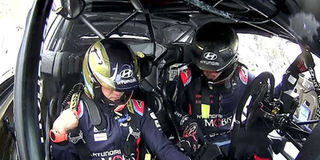Tanak crash vindicates WRC safety precautions

In this video grab taken from handout footage released by WRC, Estonian driver Ott Tanak (R) and his co-driver Martin Jarveoja unbuckle from their seats after leaving the course during the 7th special stage between Saint Clément-sur-Durance and Freissinière on January 24, 2020, as part of the Monte-Carlo rally, first stage of the WRC championship.
What you need to know:
- Tanak’s crash, beamed live with over two million people watching on YouTube, defined the start of the 2020 WRC season which will be shaped by live television coverage, peaking in Kenya’s Safari Rally in July.
The dramatic and life-threatening 160 kilometres per hour crash by world rally champion Ott Tanak’s Hyundai i20 at last weekend’s Monte Carlo Rally served two notices: One, that a modern World Rally Championship car is engineered with safety a huge priority and, two, underneath the “softie” look associated with road-going machines like the Toyota Vitz — the WRC Toyota Yaris brand equivalent — racing cars today are mean machines packed with cutting edge technology and military standard hardware engineered to withstand crashes, rolls and safeguard the human life caged inside a matrix of steel or tubular frames.
The safety aspects of modern cars, as proved by Tanak’s crash, saved the sport from the ignominy of taking the same path which killed Group ‘B’ cars in rallying most exciting generation, following the death of Henri Toivonen and Sergio Cresto in a Lance Delta S4 after plunging into a ravine and bursting into a ball of flames on May 1, 1986.
Tanak’s crash, beamed live with over two million people watching on YouTube, defined the start of the 2020 WRC season which will be shaped by live television coverage, peaking in Kenya’s Safari Rally in July.
Tanak crash was another reminder of how fickle rallying is, and that the line between life and death is minute thin.
To maintain safety, WRC Safari Rally spectators will be barred from accessing the inside of corners and shall be restricted to 90 feet away from the road. WRC Safari Rally safety and security heads Norris Ongalo and Police Commissioner Julius Kabiru have embarked on an elaborate plan to secure the route.




